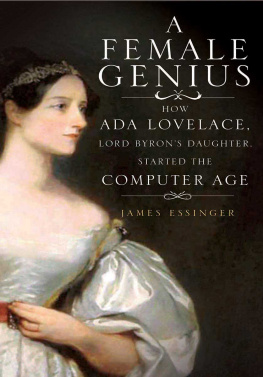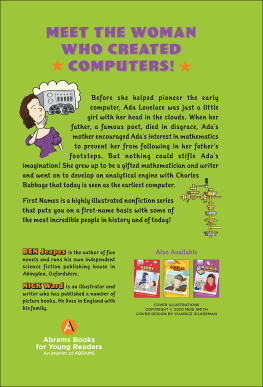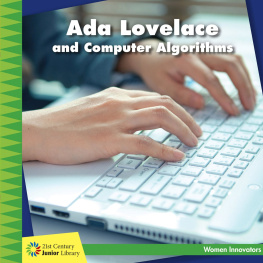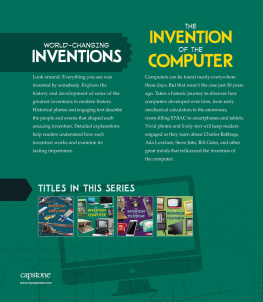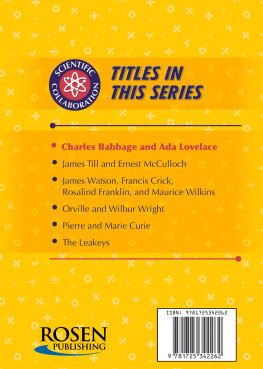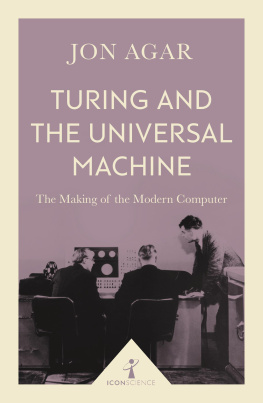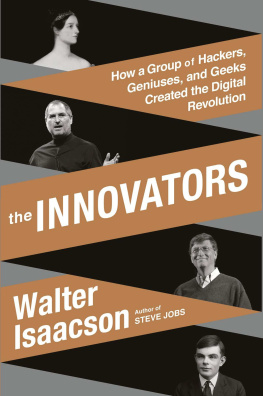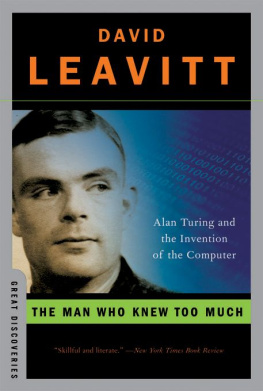Ada Lovelace, Lord Byrons only legitimate daughter, was rediscovered in the 1930s by computer pioneers such as Alan Turing. Four decades on, a new generation of computer programmers named a widely-used programme Ada in honour of her achievements.
A Female Genius tells the astonishing story how Ada Lovelace would have started the computer age almost two centuries ago, in 1840s London, but for the fetters of social conventions that are felt to this day. It shows how Ada Lovelace was the only one who understood this, despite opposition that the principles of science were beyond the strength of a womans physical power of application.
Ada Lovelace wrote the worlds first computer programme and foresaw that music would be created by computers and the emergence of computer science (which she called poetical science). Hers is one of the most exceptional and inspirational stories in the history of science.
James Essingerprevious book, Jacquards Web: How a Hand-Loom Led to the Birth of the Information Age (OUP 2004) was chosen as one of the top 5 popular science books of the year by the Economist . While writing this book he got fascinated by Ada Lovelace, who some scientists still consider overrated the reason why he researched this book. James Essinger read English at Lincoln College, (University of Oxford) and lives in Canterbury.
Dans un livre qui voudrait raconter une [vie], il faudrait user, par opposition la psychologie plane dont on use dordinaire, dune sorte de psychologie dans lespace puisque la mmoire, en introduisant le pass dans le prsent sans le modifier, tel quil tait au moment o il tait le prsent, supprime prcisment cette grande dimension du Temps suivant laquelle la vie se ralise.
In a book attempting to tell the story of a human life, a normal, one-dimensional psychological approach would have to be abandoned, in favour of something more fluidbecause, when memory represents the past in the present,without modification, what is lost is the self-same rich dimension of Time, in which actual life experience occurs.
Preface
I became fascinated by Ada Lovelace while writing my book Jacquards Web: How a Hand-Loom Led to the Birth of the Information Age (2004), by which time a general interest in Adas work was well-established. There is a popular software language called Ada that was originally developed by the US Ministry of Defence in the late 1970s to unite a host of different programming languages. In 2009, the International Ada Lovelace Day was launched on Londons Southbank to celebrate the achievement of women in science, technology, engineering and mathematics. There is a Hollywood movie about Ada (written by Shanee Edwards), Enchantress of Numbers, in development.
It would, at least at first glance, appear that science has a chequered record of treating women as equals of men. Indeed, female staff at Bletchley Park, the wartime decryption HQ that cracked German ciphers, were largely unrecognised for their painstaking work. Meanwhile Rosalind Franklin, who did much of the unrecognised Nobel-Prize-winning work on DNA, was ignored in all official recognition of the deduction of the existence of the double helix, to the embarrassment of the male scientists involved.
Whether this is historically a case of sexism or social conditioning of both genders is beyond the scope of this book. (Change is afoot for the future as Lin Ostrom quipped on becoming in 2009 the first female Nobel Prize winner for economics, I wont be the last.) What is clear, though, is that there is a surging interest in the history of women and their contribution to and involvement with science.
While Byron cast a long shadow over Adas life, she was only six weeks old when they parted company for ever and so she never met him in any meaningful sense. The more important person was Lady Byron, who had been well-educated by her enlightened parents and moved in liberal circles. She maintained a ferocious control over her daughters life and, as it would turn out, death.
The man with whom Ada Lovelaces story is most closely interwoven is that of her close friend Charles Babbage, the scientist who invented the first mechanical computer. Like Babbage, Ada was tireless in the pursuit of knowledge. She once wrote to him:
I wish to add my mite [might] towards expounding & interpreting the Almighty, & his laws & works, for the most effective use of mankind; and certainly, I should feel it no small glory if I were enabled to be one of his most noted prophets (using this word in my own peculiar sense) in this world.
Their letters became so intimate that some think that theirs might have a been a romantic friendship.
Unlike Babbage himself, Ada Lovelace saw beyond the immediate purpose of his invention. He had little interest in that question and appears to have seen his invention as a mere calculator. She understood that a whole new area of discovery awaited once the real world and abstract mathematics were linked through calculations that no human could ever hope to undertake. She speculated that such a computer, for example, might handle pieces of music of any degree of complexity or extent: a very familiar truth over a century and a half later but inconceivable to scientists at the time.
Ada was passionate, kind, imaginative, excitable and emphatic. She loved emphasising words in the letters and documents she wrote by underlining them (such words are italicised where she is quoted). She was in poor health and used mathematics as a way to regain her balance. She would later in life, when she was in serious pain, use medication that we now recognise as mind-altering drugs. After a long and excruciating deathbed that she appears to have suffered without complaining, she would die of cancer at the age of thirty-six, the same age as her father Lord Byron.
One of the fiercest criticisms of Ada is found in The Little Engines That Couldve (1990) by Bruce Collier. This book, an otherwise shrewd and useful account of Babbages work, contains much highly-informed technical material. But Collier writes this about Ada:
There is one subject ancillary to Babbage on which far too much has been written, and that is the contributions of Ada Lovelace It is no exaggeration to say that she was a manic-depressive with the most amazing delusions about her own talents, and a rather shallow understanding of both Charles Babbage and the Analytical Engine To me, this familiar material seems to make obvious once again that Ada was as mad as a hatter I will retain an open mind on whether Ada was crazy because of her substance abuse I guess someone has to be the most overrated figure in the history of computing.
Against this modern opinion one can let Charles Babbage himself give the answer. He wrote about Ada Lovelace on September 9 1843 to Michael Faraday, the nineteenth-century polymath who discovered electrolysis and magnetic induction:
[T]hat Enchantress who has thrown her magical spell around the most abstract of Sciences and has grasped it with a force which few masculine intellects (in our own country at least) could have exerted over it.
I hope that A Female Genius will make it clear that Ada Byron, later Countess of Lovelace, Lord Byrons only legitimate daughter, should without doubt be included in the list of overlooked women whose potential was treated casually merely because of their gender. There has so far been no biography of Ada that fully defends the genius of her thinking, which prompted me to write this book. Adas grasp of complex questions came with such ease that she was able to see beyond it where others needed to work hard to understand even the question itself.

